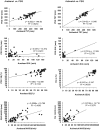Assessing sleep disturbance in low back pain: the validity of portable instruments
- PMID: 24763506
- PMCID: PMC3998977
- DOI: 10.1371/journal.pone.0095824
Assessing sleep disturbance in low back pain: the validity of portable instruments
Abstract
Although portable instruments have been used in the assessment of sleep disturbance for patients with low back pain (LBP), the accuracy of the instruments in detecting sleep/wake episodes for this population is unknown. This study investigated the criterion validity of two portable instruments (Armband and Actiwatch) for assessing sleep disturbance in patients with LBP. 50 patients with LBP performed simultaneous overnight sleep recordings in a university sleep laboratory. All 50 participants were assessed by Polysomnography (PSG) and the Armband and a subgroup of 33 participants wore an Actiwatch. Criterion validity was determined by calculating epoch-by-epoch agreement, sensitivity, specificity and prevalence and bias- adjusted kappa (PABAK) for sleep versus wake between each instrument and PSG. The relationship between PSG and the two instruments was assessed using intraclass correlation coefficients (ICC 2, 1). The study participants showed symptoms of sub-threshold insomnia (mean ISI = 13.2, 95% CI = 6.36) and poor sleep quality (mean PSQI = 9.20, 95% CI = 4.27). Observed agreement with PSG was 85% and 88% for the Armband and Actiwatch. Sensitivity was 0.90 for both instruments and specificity was 0.54 and 0.67 and PABAK of 0.69 and 0.77 for the Armband and Actiwatch respectively. The ICC (95%CI) was 0.76 (0.61 to 0.86) and 0.80 (0.46 to 0.92) for total sleep time, 0.52 (0.29 to 0.70) and 0.55 (0.14 to 0.77) for sleep efficiency, 0.64 (0.45 to 0.78) and 0.52 (0.23 to 0.73) for wake after sleep onset and 0.13 (-0.15 to 0.39) and 0.33 (-0.05 to 0.63) for sleep onset latency, for the Armband and Actiwatch, respectively. The findings showed that both instruments have varied criterion validity across the sleep parameters from excellent validity for measures of total sleep time, good validity for measures of sleep efficiency and wake after onset to poor validity for sleep onset latency.
Conflict of interest statement
Figures

Similar articles
-
Improving Sleep Quality Assessment Using Wearable Sensors by Including Information From Postural/Sleep Position Changes and Body Acceleration: A Comparison of Chest-Worn Sensors, Wrist Actigraphy, and Polysomnography.J Clin Sleep Med. 2017 Nov 15;13(11):1301-1310. doi: 10.5664/jcsm.6802. J Clin Sleep Med. 2017. PMID: 28992827 Free PMC article.
-
Validity of Actigraphy in Measurement of Sleep in Young Adults With Type 1 Diabetes.J Clin Sleep Med. 2017 May 15;13(5):669-674. doi: 10.5664/jcsm.6580. J Clin Sleep Med. 2017. PMID: 28162146 Free PMC article.
-
Comparison of Polysomnography, Single-Channel Electroencephalogram, Fitbit, and Sleep Logs in Patients With Psychiatric Disorders: Cross-Sectional Study.J Med Internet Res. 2023 Dec 13;25:e51336. doi: 10.2196/51336. J Med Internet Res. 2023. PMID: 38090797 Free PMC article.
-
Home assessment of sleep disorders by portable monitoring.J Clin Neurophysiol. 1996 Jul;13(4):272-84. doi: 10.1097/00004691-199607000-00002. J Clin Neurophysiol. 1996. PMID: 8858490 Review.
-
Measurements and status of sleep quality in patients with cancers.Support Care Cancer. 2018 Feb;26(2):405-414. doi: 10.1007/s00520-017-3927-x. Epub 2017 Oct 23. Support Care Cancer. 2018. PMID: 29058128 Review.
Cited by
-
Association of serum 25-hydroxyvitamin D concentrations with sleep phenotypes in a German community sample.PLoS One. 2019 Jul 5;14(7):e0219318. doi: 10.1371/journal.pone.0219318. eCollection 2019. PLoS One. 2019. PMID: 31276483 Free PMC article.
-
Actigraphy-Based Sleep Detection: Validation with Polysomnography and Comparison of Performance for Nighttime and Daytime Sleep During Simulated Shift Work.Nat Sci Sleep. 2022 Oct 14;14:1801-1816. doi: 10.2147/NSS.S373107. eCollection 2022. Nat Sci Sleep. 2022. PMID: 36275180 Free PMC article.
-
Sleep Indices and Cardiac Autonomic Activity Responses during an International Tournament in a Youth National Soccer Team.Int J Environ Res Public Health. 2021 Feb 20;18(4):2076. doi: 10.3390/ijerph18042076. Int J Environ Res Public Health. 2021. PMID: 33672683 Free PMC article.
-
Objective sleep in pregnant women: a comparison of actigraphy and polysomnography.Sleep Health. 2018 Oct;4(5):390-396. doi: 10.1016/j.sleh.2018.07.011. Epub 2018 Aug 26. Sleep Health. 2018. PMID: 30241652 Free PMC article.
-
High Intensity Interval Training Does Not Have Compensatory Effects on Physical Activity Levels in Older Adults.Int J Environ Res Public Health. 2020 Feb 8;17(3):1083. doi: 10.3390/ijerph17031083. Int J Environ Res Public Health. 2020. PMID: 32046311 Free PMC article. Clinical Trial.
References
-
- Hoy DG, Bain C, Williams G, March L, Brooks P, et al. (2012) A systematic review of the global prevalence of low back pain. Arthritis Rheum 64: 2028–2037. - PubMed
-
- Manchikanti L, Singh V, Datta S, Cohen SP, Hirsch JA, et al. (2009) Comprehensive review of epidemiology, scope, and impact of spinal pain. Pain Physician 12: E35–70. - PubMed
-
- Marin R, Cyhan T, Miklos W (2006) Sleep disturbance in patients with chronic low back pain. Am J Phys Med Rehab 85: 430–435. - PubMed
-
- Kelly GA, Blake C, Power CK, O'Keeffe D, Fullen BM (2011) The association between chronic low back pain and sleep: a systematic review. Clin J Pain 27: 169–181. - PubMed
Publication types
MeSH terms
LinkOut - more resources
Full Text Sources
Other Literature Sources
Medical
Miscellaneous

